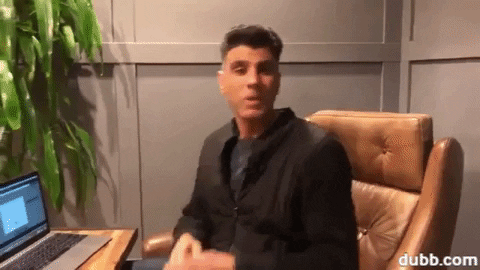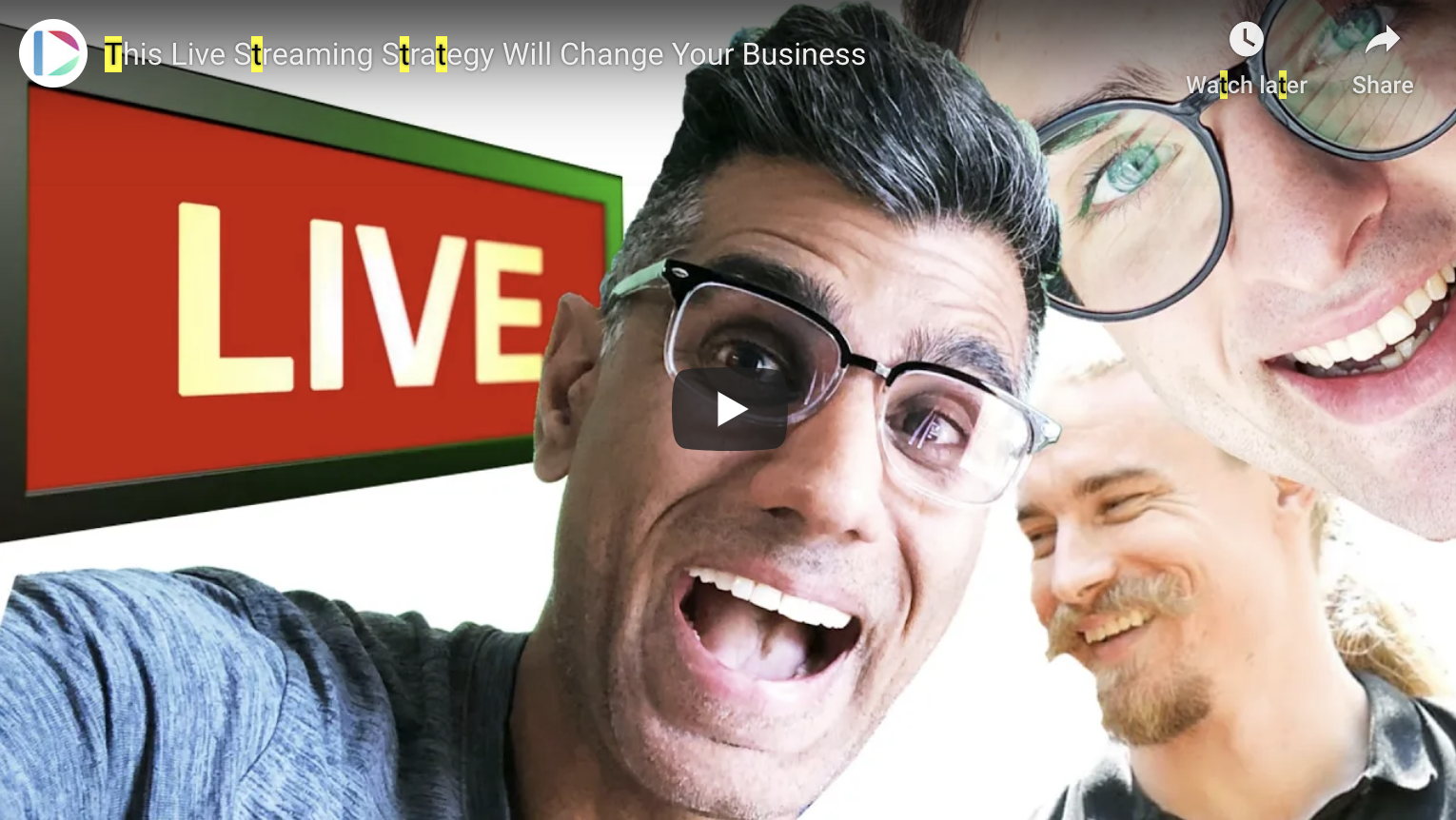In the world of sales and marketing, a live streaming strategy can be a great way to accelerate your business. Leveraging the power of live video, you can more closely connect with your prospects and increase your odds of generating new sales.
If you haven’t already adopted a live streaming strategy, it’s generally a great idea to do so. Having said this, actually implementing a stellar live streaming strategy can be easier said than done. As with many sales and marketing strategies, there are certain nuances or subtle details that can make the difference between failure and success.
I want to spend this article talking about live streaming and how you can maximize your chances of achieving your live streaming goals. While you may make some mistakes in the beginning, implementing these tips and insights can substantially strengthen your live streaming strategy.
When Not to Live Stream
Before getting into the details of how to conduct the best possible live stream, I think that it’s important to take a few moments to discuss when not to live stream. Live streaming can offer so many benefits for you and your audience. But as you can guess, it isn’t right for every single situation.
For instance, YouTube is a terrific platform for building long-term audiences with short to medium-form produced content. While it can also be a good choice for live videos, the platform favors produced video content.
Dubb.com is also a great solution for sending out asynchronous videos. Asynchronous videos are all about sending quick video messages to someone to get a result. Dubb is also a terrific outlet for sending out videos for business communication, for getting results with calls to action, or even booking a time on your calendar with a customized video above the calendar. If you want to use video to get sales and marketing results, Dubb can be a great choice for you.

These are just some of the situations where live streaming may not be the ideal solution. I’m not saying that you should prioritize live streaming or non-live streaming. The point here is to be strategic. Make sure you are being conscious of why you are live streaming or foregoing live streaming. Doing so will make your video content more engaging and will help you accomplish your video goals.
The Most Important Thing in Live Streaming
When developing a live streaming strategy, there are many different things to keep in mind. Nonetheless, I think that there is one thing that is more important than many of the other factors that you must keep in mind.
It comes down to practice.
Let’s face it: live streaming may not be the most natural thing. For many of us, it can feel weird or awkward to stare into a camera and speak extemporaneously to tens, hundreds, or even thousands of people. You aren’t necessarily getting the feedback that you would receive when you’re giving a talk in front of a live audience.
Yet while live streaming may not feel completely natural, the silver lining is that we can keep practicing.
I know from experience. By this point, I have recorded around 700 live videos. Even though I’ve been on camera more often than most, I’m still getting the hang of it. I’m constantly adapting my style on-camera. In the end, there is always something new to learn.
Critically, however, it’s not like I’m learning an exciting new method or strategy and then doing nothing. I’m incorporating it into my video content. In other words, I’m actively trying different things—even if they may fail.

This may seem intimidating—especially if you are uncomfortable making video content. I promise you that it gets better. The earliest days are the hardest. However, by continuing to get in front of the camera and put great content out there, you will undoubtedly improve.
A Story of How We Leveraged Live Streaming to Grow Our Business
So you know that practice is important to leverage live streaming. Without it, you’re going to find it difficult—no matter how valuable your content is.
But to illustrate the power of live streaming, I want to share a brief story from my company Dubb. As you may already know, Dubb is a video communications platform for both salespeople and marketers. Using our software, you can leverage the power of video to accomplish your sales and marketing goals.
In the earlier days of Dubb, my team and I quickly discovered that we were experiencing a bottleneck. Essentially, we weren’t able to deliver the demos that we needed to all of our users. This was a real problem, as we wanted to use these demos to showcase everything that Dubb had to offer.
The solution? We kind of broke the rules and went live with our sales calls. Moreover, we recorded these live demos and then broadcasted them onto our social channels.
Ultimately, we had some great successes with this solution. By showing our sales calls to other Dubb prospects and current users, we were able to show the value of Dubb. Our audience could not only see Dubb’s powerful features, but our enthusiasm for the product. While it was unconventional, our live streaming strategy was a great workaround to solve our demo issue. At the same time, these recordings ended up being a huge sales tool for our company.

You may not be in the same exact position as we were. Maybe you have a great way of distributing your demos to your prospects and users. That said, you may be facing another pressing issue that can be solved through a live streaming strategy. Don’t hesitate to leverage it if you need an effective way to communicate with a particular audience.
Planning Your Live Stream
So considering all of the above, let’s now talk about how you want to go about planning your live stream. While there may be some interruptions in your live stream, you still want to put in the time so that it goes as smoothly as possible. Moreover, you want your live stream to keep moving and stay exciting. Doing this helps your audience stick around and respond to whatever call to action that you’re promoting.
One helpful thing I’ve found is to create an outline for your live stream.
Your outline doesn’t need to be overly long or complicated. It can include some of the major points that you want to make during your recording. I’d also specifically recommend that you plan your openings and your transitions. These can be tricky to navigate if you are speaking off-the-cuff.
Because of this, don’t hesitate to write down a few ideas for these important segments of your live stream. These parts do not need to be set in stone. If you are in a rhythm and intuitively sense that your transition should be different, feel free to alter them. The act of planning these out, however, is a great exercise to organize your thoughts and put on a better live stream.
From creating an outline from your live stream, you’ll next want to consider the many services that you can use to go live.
For instance, you can use tools like Streamyard, Onstream, and Restream. With a service like Streamyard, you can easily stream to multiple services—all at the same time. This can be extremely powerful, especially if you want to increase your footprint during your live streams. Using a service like Streamyard, you can easily get the job done.
Many people also don’t recognize that you can go live on Zoom. Specifically, Zoom gives you the ability to connect to your YouTube or Facebook accounts. This provides you with tremendous flexibility. For any conference call or webinar that you may have, you can use Zoom to have them live-streamed to your social media channels.
Whichever platform you choose, make sure that you are completing your due diligence. Research these different streaming platforms and ensure that they have the features that you need.
As a side note, we have a partnership with Streamyard. If you would like to learn more, head on over to dubb.com/streamyard.
From there, think about your distribution strategy.
Live videos are typically a better solution if you are trying to attract an audience. It’s important to recognize that they are less searchable in the future.
Because of this, if you are looking to create evergreen content on a YouTube channel, it’s often good to leverage a live and repost strategy. It’s straightforward. Simply start your live stream when you want and then repost that live stream to your social media channels. This way, you get the initial audience of a live video and the SEO and long-term visibility of a produced video.
If you aren’t as concerned about getting the SEO benefits of your live stream, you don’t necessarily have to post your live streams to social media. That being said, there are many reasons why you should. You never know if there is a key prospect who didn’t catch your live stream, but who wants to view it on social media later. Along with this, there are few (if any) marginal costs of uploading your video to social media platforms. To put it another way, there are really no financial reasons why you shouldn’t upload your live streams to your social media channels.
Recording Your Live Stream
A large part of an effective live streaming strategy comes down to preparation. Putting in the work before you start recording can help you save time and help you create better live streams. You don’t want to ignore it.
That said, planning only goes so far. You need to get in front of the camera and actually record your content.
Like I said above, practice is at the heart of becoming a better live streamer. There’s no way around it, so it’s in your interest to embrace it from the start. Even though it can be discouraging at first, sticking with it (and learning from your mistakes) will accelerate your progress.
Beyond practice, however, I encourage you to think about audience engagement when you are live streaming.
Granted, this can be difficult when you are starting out. You are more likely focusing on the words that you’re saying rather than how your audience is reacting to those words. Especially when you are at the beginning and only have a few audience members, what’s the harm, right?
It may be tempting to take that perspective, but I’d encourage you to pay close attention to your viewers. By treating your audience members like friends or members of your family, you can increase engagement. And by increasing engagement? You can get new audience members to view your live streams, which will attract even more followers. Along the way, some of those audience members will actually purchase your product or service.
One of the best ways to increase audience engagement is to respond to every single comment when you’re live. You can respond on the live stream and in the comments by typing replies in real-time. And by “respond,” I don’t mean you need to include a long-winded response. You can acknowledge the comment in whatever form you’d like. Doing this will really help you drive interactions and get people to share your content. This is because they will intuitively feel like they are involved in your live stream.
Along with responding to comments and feedback, make sure to encourage tags and sharing.
This is a great way to spread the word about your live stream and your company as a whole. During your live stream, make sure to tell your audience to tag a friend, family member, or colleague that would be interested in the live stream. My colleagues and I have found it a great way to grow your viewership in real-time.
All you need to do is ask. You never know what may happen.
Finally, whenever we are recording live video content, we must lean into the realities of recording live video.
Interruptions are common. Flubs may happen. Your kids and pets may interrupt your train of thought or just cause a general ruckus in your video. Much of the time, there is nothing that you can do about these distractions. You just need to roll with them.

That being said, these interruptions can also offer a positive benefit. You may not realize it at the time, but they make your videos more human. They make you more authentic—even if you are talking about a “serious” business topic. While you shouldn’t be looking to manufacture these moments, these moments, if they occur organically, can offer a silver lining to the interruption.
So if you do get interrupted during a live stream, don’t panic. It’s not going to scuttle what you are trying to do in your live stream. In fact, it may offer you some subtle benefits that can pay off in the future. Just relax and keep going.
After Your Live Stream: Leveraging the Waterfall Method
So once the recording has concluded, many may think their work is done. After all, one of the best parts about live streaming is that hosts get to engage with their audiences in real-time. But like I mentioned above, an important part of a successful live stream is marketing it after you’ve finished recording.
Yes, it is critical to publish your live stream to social media channels. This includes everything from Facebook and Twitter to YouTube and LinkedIn. To reiterate, this is a great way to generate new content for your old followers and to show new followers that you are knowledgeable and skilled in your industry.
In our experience, however, one of the most effective marketing strategies is leveraging Dubb’s Waterfall Method.

At its core, the Waterfall Method is all about taking long-form content and chopping it up until smaller and smaller clips. These smaller clips can then be shared through email or your social media channels.
Whether they are one to two-minute clips of a striking insight from your live stream to a quick 30-second promo for the live stream itself, reusing your long-form content in this way creates a multiplying effect. From one 60-minute live stream, for instance, you can create much more content that you can serve to your audience.
Ultimately, there are likely key moments in your live stream that you can use to attract new audience members. Identify those parts of your live stream and extract them from the video. With that new clip, we recommend that you follow certain editing guidelines. For instance, make sure that those clips are in a square format. In that format, you should include text on the top, captions on the bottom, and a very concise video in the center. An example is below:

Through our work at Dubb, we have found that the square format works the best for these types of videos. If you want to leverage the Waterfall Method and repurpose your live stream content, I highly encourage you to follow these guidelines. Before you know it, you’ll find new audience members eagerly awaiting your content.
Creating a Top-Tier Live Streaming Strategy
While live streaming technology isn’t brand new, there are still so many underrated benefits to using it in your business. In fact, I’d argue that the value of live streaming was the most valuable thing that I learned last year.
In our normal workday, we have sales meetings, webinars, and training calls. While these events are valuable in and of their own right, all of them can be turned into live videos.
Live videos force us to publish on social channels like YouTube, Facebook, and LinkedIn. It’s a natural part of the process. The added benefit from posting is that our posted content attracts new leads, new clients, and new prospects. Really, live videos are the gift that keeps on giving.
Here’s how to really take advantage of it. You can simply go to dubb.com/streamyard to sign up for an account. Then, go ahead and set up your live stream and select all of the social channels that you want. This includes everything from Facebook, LinkedIn, and YouTube to Twitter, Periscope, and Twitch. Your video will then go directly live. Later, you can even take your live stream down and edit it. Doing this, you can make a sales pitch for one person into a sales pitch for 41 people.
Finally, if you’d like to learn more about Dubb, I encourage you to contact us. Dubb can be the tool you need to accomplish your sales and marketing goals. If you are interested in trying it out for yourself, go ahead and click here to sign up for a free 7-day trial of our premium product.


